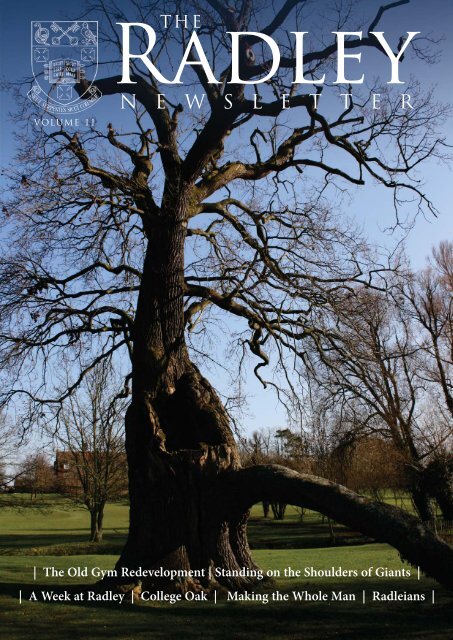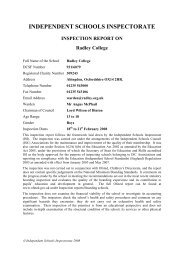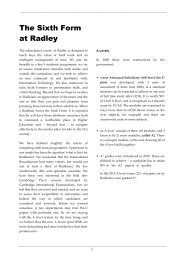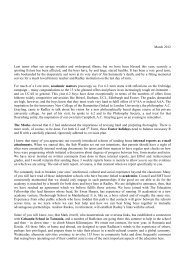N E W S L E T T E R - Radley College
N E W S L E T T E R - Radley College
N E W S L E T T E R - Radley College
You also want an ePaper? Increase the reach of your titles
YUMPU automatically turns print PDFs into web optimized ePapers that Google loves.
<strong>Radley</strong><br />
THE<br />
N E W S L E T T E R<br />
VOLUME 11<br />
| The Old Gym Redevelopment | Standing on the Shoulders of Giants |<br />
| A Week at <strong>Radley</strong> | <strong>College</strong> Oak | Making the Whole Man | Radleians |
<strong>College</strong> Oak<br />
Every Wednesday evening Radleians congregate in their boarding houses for ‘Social Prayers’. Talks are given<br />
by dons which may have a moral or spiritual element, often they relate to events in the news, but sometimes<br />
they simply inform the boys about interesting ideas and facts which might not otherwise find their way into a<br />
curriculum. This is an address given by the Acting Warden, Andrew Reekes:<br />
Standing at the bottom of a broad track, alongside<br />
Capability Brown’s picturesque lake, is a gnarled<br />
and twisted oak tree of considerable girth and<br />
obvious antiquity. Since <strong>Radley</strong>’s early days it has<br />
been known as <strong>College</strong> Oak, but <strong>Radley</strong> <strong>College</strong><br />
is a Johnny-come-lately when set alongside this<br />
noble tree, which dendrochronologists from the<br />
EU have recently dated as being c.1060 years<br />
old. In truth, it is one of the oldest extant trees<br />
anywhere in Europe.<br />
Pigs foraging for pannage through the forests<br />
attached to Abingdon Abbey evidently missed a<br />
stray nut. It took root at a time when Edgar the<br />
Peacable, from Wessex, was King of England and<br />
St Aethelwold the Bishop of Winchester held the<br />
Abbacy at Abingdon and so owned the woods.<br />
The tree was already a century old when William<br />
of Normandy conquered England; he came to<br />
Abingdon in 1084 to celebrate Easter, hunted<br />
boar across <strong>Radley</strong> land and left his son, later<br />
to be Henry 1st, to board at the Abbey. <strong>College</strong><br />
Oak grew and flourished through the Angevin<br />
and Plantagent centuries, one of scores of such<br />
trees in these parts. A layman here would have<br />
been trespassing and it is likely that only boar<br />
and deer sheltered under its boughs; perhaps the<br />
occasional courting couple romped in its leafy<br />
shelter.<br />
At some stage, centuries ago, a lightening strike<br />
or a natural deformity led to a strange perversion<br />
which makes <strong>College</strong> Oak unique; its 60 foot<br />
long sideshoot, as thick as a child is high, lying<br />
parallel to the ground and rooting in the soil in<br />
its own right. It probably explains why the tree is<br />
here today. With Henry VIII came a passionate,<br />
competitive, dynastic desire to make a mark in<br />
Europe and war inevitably meant the need to<br />
defend these shores with a strong navy. Henry<br />
ordered the building of huge oak men-of-war of<br />
which the Mary Rose was one example. Because<br />
of its size, and height, and the design of is<br />
gunports it shipped water and turned turtle one<br />
benign summer’s day on the Solent. Surveyors<br />
then, as in the time of his daughter Elizabeth,<br />
scoured the south of England for thick, tall,<br />
straight oak timber. <strong>Radley</strong>’s was even then too<br />
old, too bent, to pass muster. As in the late 18th<br />
century when the Admiralty looked for English<br />
oak to construct a navy against Bourbon, then<br />
Revolutionary, finally Napoleonic, France,<br />
<strong>College</strong> Oak survived the cull.<br />
By then, too, something else had happened to it.<br />
It had been incorporated into the leisure industry<br />
of its era. Capability Brown, the greatest garden<br />
designer of his era, architect of over 140 such<br />
schemes, was employed here to landscape the<br />
grounds surrounding newish <strong>Radley</strong> Hall on<br />
lands freed, after Henry VIII’s dissolution, from<br />
ecclesiastical ownership. Capability Brown’s<br />
style was one of smooth, undulating grass<br />
accompanied by artistically devised clumps and<br />
softening of trees, with serpentine lakes, all with<br />
the aim of creating the gardenless garden. <strong>College</strong><br />
Oak was a picturesque prop in an 18th century<br />
stage set, part of a contrived landscape in the style<br />
of Claude Lorraine.<br />
Its final incarnation, now 900 years old, was to<br />
act as bit part player in the new <strong>Radley</strong> <strong>College</strong>,<br />
founded in 1847. So hungry were early Radleians<br />
that they foraged like those Anglo-Saxon wild<br />
boar of old, for acorns from <strong>College</strong> Oak; they hid<br />
tuck from prying authorities in its hollow interior.<br />
At some stage – not, of course, now – it was also<br />
the secret repository of illicit cigarettes and the<br />
occasional bottles of hooch. By the 21st century<br />
it was, indeed, a hollowed-out oak, a hoary old<br />
growth, but it still had life, and survived the<br />
attentions of tree surgeons round the grounds in<br />
the last decade.<br />
So, it is rather humbling to review what it has<br />
outlived. It was 100 years old when the Normans<br />
came, 400 years old when England’s population<br />
was halved by Black Death, 600 years old when<br />
Shakespeare was born, 700 years old when<br />
Royalists and Parliamentarians surged to and<br />
fro across <strong>Radley</strong>’s lands as they contested the<br />
Thames Valley and Royalist Oxford; 850 years old<br />
when beacons were lit across Southern England to<br />
warn of impending invasion by Napoleon in 1805;<br />
the tree celebrated its millennium as Radleians<br />
and Eastbournians (evacuated here for the war’s<br />
duration) gazed skywards at German bombers<br />
passing north overhead to seek out Birmingham<br />
and Coventry. It is quite extraordinary that a<br />
living thing could have survived so much – over<br />
1000 years – of our island history. That survival<br />
perfectly illustrates why we revere the oak tree<br />
– its resilience, strength and durability has long<br />
symbolised those enduring rugged, yeoman<br />
qualities of the idealised Englishman.<br />
8 THE RADLEY NEWSLETTER<br />
THE RADLEY NEWSLETTER 9<br />
THE RADLEY NEWSLETTER 9

















